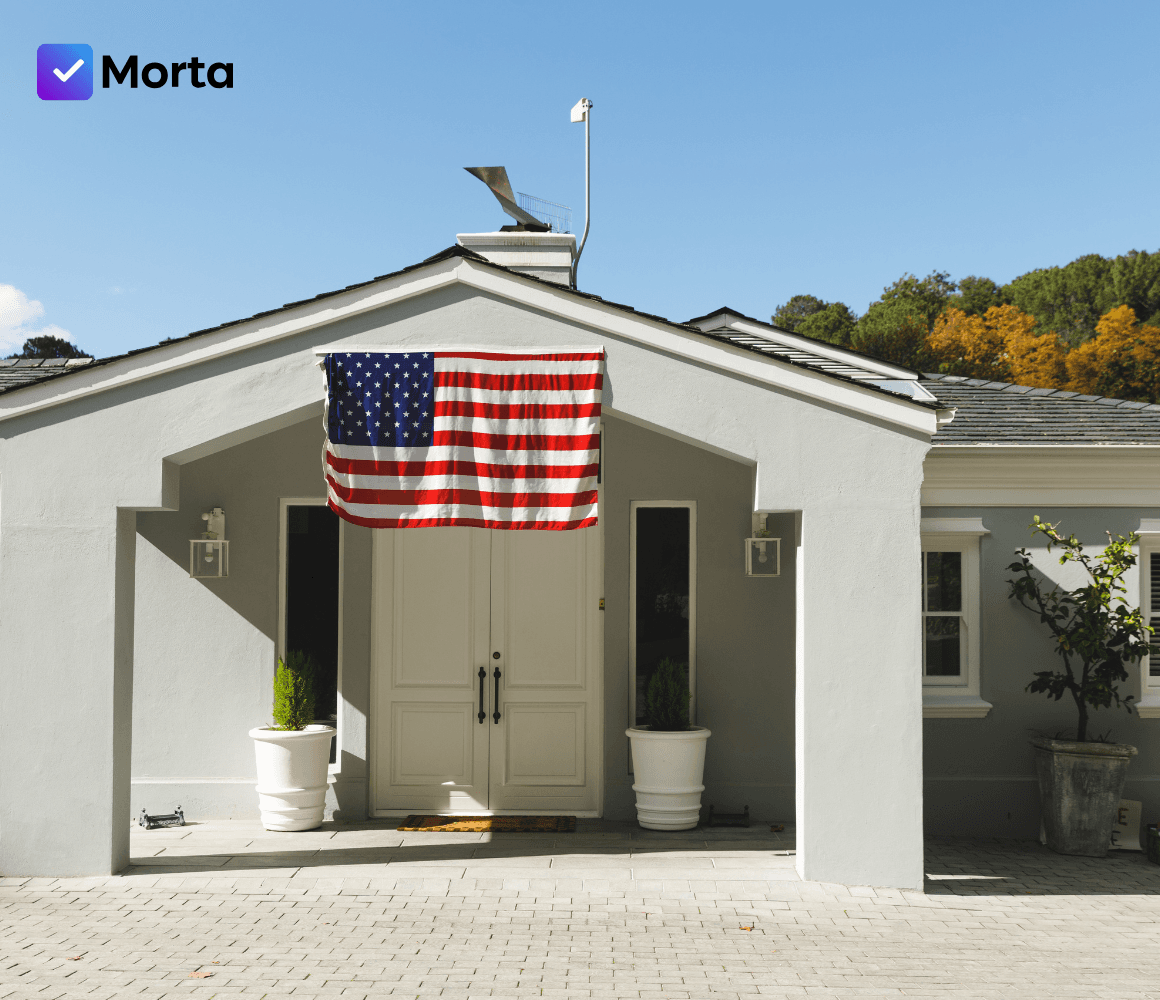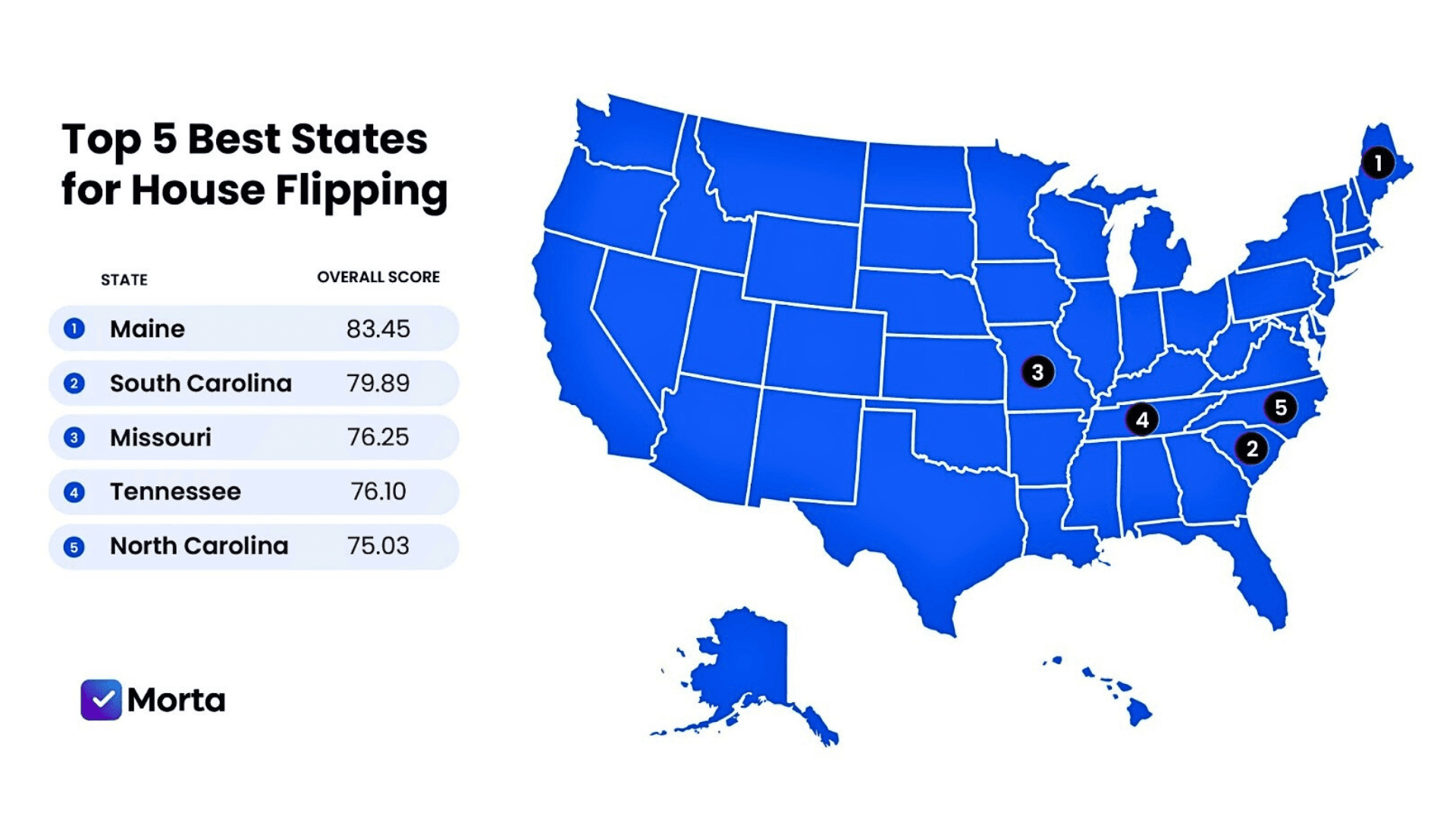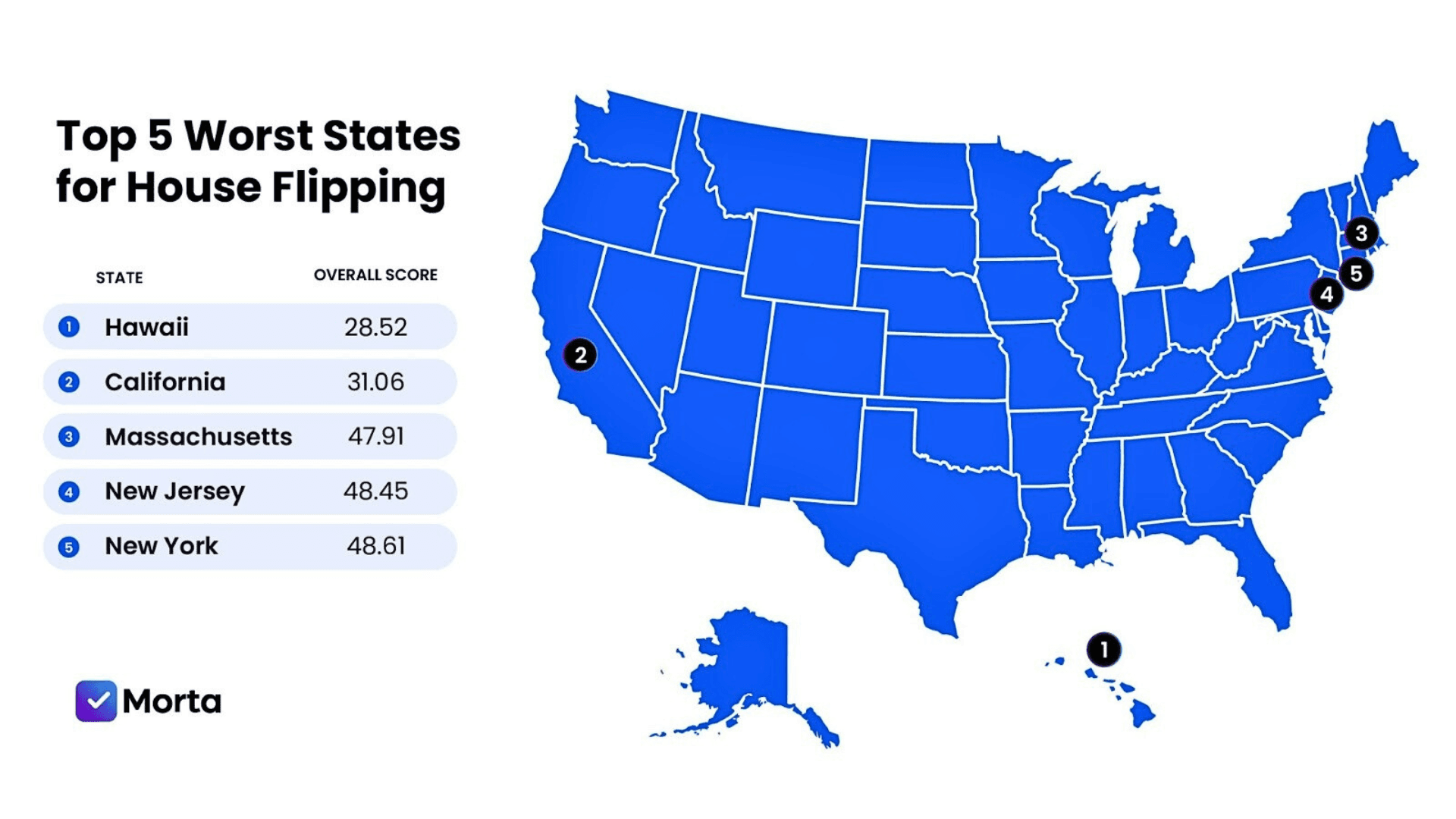Alyssa Castillo

Flipping refers to buying property for the purpose of renovating or improving it and selling it quickly at a profit. It can deliver great returns, but it carries great risk, which is why the location where one chooses to buy and resell property matters.
As a leading provider of property development software for developers, investors, and real estate professionals, Morta knows property flippers must prioritize markets with excellent liquidity, rising property prices, a large pool of financially capable buyers, and lower renovation and tax-related costs.
Drawing on our global expertise and knowledge of the U.S. housing market, we created a data-driven system that scores the United States’ 50 member states across various criteria and ranks them according to their attractiveness to house flippers. We present the results below and highlight the best and the worst U.S. states for house flipping.
The top five states for house flipping in the United States are Maine, South Carolina, Missouri, Tennessee, and North Carolina.

Maine is the best state for house flippers, earning the highest overall score of 83.45 out of 100. Registering 149.18 Home Sales per 100,000 People, it ranks first among all U.S. states in housing market sales activity, which indicates consistent buyer demand and a speedy resale turnaround for house flippers. Driving this demand are the state’s moderate market entry price (Median Property Price is $381,000) and the properties’ relative affordability to typical buyers (Metro Price-to-Income Ratio is 4.48).
Maine ranks second in Five-Year Sale Price Change (63%), confirming the strong buyer demand and demonstrating a strong capital appreciation potential. The state’s Average Remodeling Cost ($27,468), the lowest in the country, adds to Maine’s appeal as it minimizes renovation costs and increases profit margins. Due to Maine’s highly liquid housing market, impressive market momentum, and low renovation costs, house flippers can look forward to quick resale turnarounds and excellent returns.
South Carolina is the second-best state for house flipping, with an overall score of 79.38. Its 113.86 Home Sales Per 100,000 People establishes it as one of the U.S. states with the highest housing demand. It is expected that this demand will hold and may increase in the future due to a steady inflow of people (i.e., potential home buyers), which is reflected by a Net Domestic Migration Rate of 12.5, the highest among all U.S. states.
Naturally, the influx of people relocating to Maine is driving up prices (Median Property Price is $381,000). Notwithstanding the higher price to entry, the heightened buyer demand is powering growth (Five-Year Sale Price Change is 47.86%) and outpacing renovation costs (Average Remodeling Cost is $36,309, among the lowest in the country), so investors can expect to buy and resell quickly at a healthy profit.

Missouri ranks third overall with a score of 76.25. One of Missouri’s biggest advantages is the absence of a transfer tax (0 Estimated Median Transfer Tax), which reduces transaction costs, while the Five-Year Sale Price Change of 47.03% further enlarges flipping profit margins.
Missouri also has the eighth most active housing market in the country, with its 110.99 Home Sales per 100,000 People, so properties spend a shorter time on the market. Market liquidity is likely fueled by the properties’ affordability, reflected by a Median Property Price of only $258,000, way below the country’s median value, and a Metro Price-to-Income Ratio of 3.52, which is among the 10 lowest in the country. In Missouri, the zero transfer tax and the growing and highly liquid market mean house flippers can do well buying and selling multiple properties.
Tennessee is the fourth most attractive state for house flipping, with an overall score of 76.1. It is the third-fastest growing market in the United States, with a Five-Year Sale Price Change of 60.16%. The population is also steadily growing, with a Net Domestic Migration Rate of 6.7, the fifth highest in the country.
If these trends continue, house flippers may find even longer sales cycles worth their while. Properties may stay longer in the market, but they can sell at a higher profit when the state’s newest settlers start house-shopping and buyer demand peaks. Such a strategy is particularly viable because of the state’s Estimated Median Property Tax ($1,862), the eighth lowest in the country. Due to the state’s excellent appreciation potential, considerable in-migration, and low property taxes, house flippers with a longer resale horizon can realize great returns in Tennessee.
North Carolina, with a score of 75.03, rounds out the five top states for house flippers. It ranks sixth overall for buyer activity, with 116.37 Home Sales per 100,000 People, and this market activity level is expected to persist because of the state’s substantial in-migration, reflected by a Net Domestic Migration Rate of 7.5, which is the fourth highest in the country.
Since North Carolina also holds the 10th spot in property appreciation values (Five-Year Sale Price Change of 47.97%, the state can deliver significant capital gains upon resale. The data suggests investors in North Carolina’s property market can look forward to sizable returns and a fairly quick resale due to an active market and sustained buyer demand.
The five worst states for house flipping in the United States are Hawaii, California, Massachusetts, New Jersey, and New York.

Hawaii is the worst state for house flipping, earning the lowest overall score of 28.52 out of 100. The state has a Median Property Price of $743,000, making Hawaii the second-most expensive property market in the United States. Its Metro Price-to-Income Ratio of 11.49, moreover, is the highest in the country, which means only select homebuyers and investors can afford a house in Hawaii. A quick resale is unlikely in these circumstances.
Flippers cannot hope for better results by holding on to inventory for several years. The state’s Five-Year Sale Price Change (14.05%) is the worst in the country and especially untenable given the anticipated long resale turnaround caused by an illiquid market (83.26 Home Sales per 100,000 People) and the outflow of people (Net Domestic Migration Rate is -6.5). Since most buyers can’t afford the exorbitant property prices in Hawaii, people are leaving the state. The stagnant market, exacerbated by the lowest potential for capital gains, makes Hawaii the least attractive to house flippers.
California ranks as the second-worst state for home flippers, with a score of 31.06. Its greatest weakness is the extreme property prices. Among all the U.S. states, it is the most expensive market (Median Property Price is $833,000) and the second most unaffordable (Metro Price-to-Income Ratio is 6.95).
Since few can afford the houses in California, people are leaving the state (Net Domestic Migration Rate is -6.1), and flippers cannot hope for a quick resale, unless they do so at a loss. The overpriced housing market also means slow growth, thus a Five-Year Sale Price Change of only 20.95%, which is the third lowest in the country. The sky-high prices that place houses beyond the orbit of most home buyers and investors, as well as the bleak resale prospects due to out-migration, mean investors in California must prepare for protracted sales cycles.
Massachusetts ranks third on the list of worst states for flipping, scoring 47.91. Its Median Property Price ($615,000) is the fourth highest among all U.S. states. Most home buyers and investors cannot afford this steep entry price point, as reflected by the high Metro Price-to-Income Ratio (5.32).
Even if an investor can afford to buy a property to flip, the Average Remodeling Cost of $51,178, one of the highest stateside, will inflate the resale price and make reselling more difficult, especially since the negative Net Domestic Migration Rate (-3.9) indicates the state is losing potential home buyers. Even a long resale cycle is not viable because of the high Estimated Median Property Tax ($5,965.50), the fifth highest in the United States. Since it’s expensive to buy, rehabilitate, and maintain a house in Massachusetts, this state is not a good market for house flipping.
New Jersey’s overall score of 48.45 makes it the fourth-worst state for house flipping. In the United States, New Jersey has the highest Estimated Median Property Tax ($9,221.70) and the fourth highest Estimated Median Transfer Tax ($3,062.77). These can swell resale prices that are already high to begin with.
The Median Property Price of $521,000 makes New Jersey the United States’ ninth most expensive market. Given the relatively slow property movement (only 81.32 Home Sales per 100,000 People) and the outward flow of people (Net Domestic Migration Rate of -3.8), house flippers are likely to swallow these taxes and any renovation costs, which can be significant as New Jersey’s Average Remodeling Cost ($50,352) is the eighth highest in the country. Indeed, the state’s high holding and transaction fees plus high renovation costs can significantly diminish a house flipper’s potential returns.

New York, with a score of 48.61, rounds out the list of the five worst states for house flippers in the United States. This state may have the fourth-highest Five-Year Sale Price Change (58.42%), but this is countered by steep property taxes, the second-highest in the country (Estimated Median Property Tax of $7,257.60). These high tax costs are less than ideal, especially since New York already has the second-highest Average Remodeling Cost ($64,889).
It is also the country’s fourth slowest-moving market (61.18 Home Sales per 100,000 People), which can be expected given the exorbitant property prices ($576,000 Median Property Price) and the negative domestic migration trend (-6.1 Net Domestic Migration). The high costs of renovating and holding property, which erode any potential returns, and the below-par market liquidity make New York one of the least attractive states for house flippers.
Below is the full data. Check it to see if your preferred state is a viable market for house flipping.
Table: U.S. states ranked from the most to the least attractive market for house flipping
| State | Home Sales per 100,000 People | Metro Price-to-Income Ratio | Estimated Median Transfer Tax ($) | Estimated Median Property Tax ($) | Five-Year Sale Price Change (%) | Median Property Price ($) | Net Domestic Migration Rate | Average Remodeling Cost ($) | Overall Score | Rank |
|---|---|---|---|---|---|---|---|---|---|---|
| Maine | 149.18 | 4.48 | 1427.42 | 3581.4 | 63.02 | 381000 | 3.8 | 27468 | 83.45 | 1 |
| South Carolina | 113.86 | 4.67 | 1176.19 | 1790.7 | 47.86 | 381000 | 12.5 | 36309 | 79.89 | 2 |
| Missouri | 110.99 | 3.52 | 0 | 2270.4 | 47.03 | 258000 | 2 | 38000 | 76.25 | 3 |
| Tennessee | 102.05 | 4.71 | 1129.33 | 1862 | 60.16 | 380000 | 6.7 | 46078 | 76.1 | 4 |
| North Carolina | 116.37 | 4.69 | 675.87 | 2281.6 | 47.97 | 368000 | 7.5 | 46078 | 75.03 | 5 |
| Alabama | 96.63 | 3.71 | 246.15 | 1011.6 | 42.7 | 281000 | 5.1 | 44139 | 74.39 | 6 |
| Idaho | 137.99 | 5.81 | 0 | 2328 | 36.71 | 485000 | 8.3 | 34135 | 73.7 | 7 |
House flippers profit by buying low, rehabilitating or improving the property, and selling high. Ideally, they want to accomplish everything in the shortest possible timeframe to minimize holding and opportunity costs.
Thus, property flippers must prioritize highly liquid markets with a steady and consistent buyer demand to keep inventory moving. To this end, they want a market with a large population of home buyers continuously bolstered by positive domestic migration. Ideally, the state must have a low entry price point, and properties must be affordable to typical home buyers. Property taxes, transfer fees, and remodeling costs must be minimal, while the potential for capital appreciation should be high.
Remaining on top of metrics that matter to property investors requires a systematic process of data collection and analysis. Property developers can capitalize on Morta’s developer-first property CRM. Aside from providing seamless integrations with project workflows and budgets, our customer relationship management software centralises contacts, stakeholders, deals, offers, and customer communications and interactions in one place. Property developers can use the wealth of data to test and weigh various factors, yielding actionable insights that are specific to their markets.
This report evaluates the attractiveness of U.S. states for house flippers using a data-driven scorecard that combines key market metrics into an overall score. The analysis draws on public data covering home sales activity, affordability, price growth, taxes, remodeling costs, and population trends.
Each factor is converted into a standardized 0–100 score, where higher values consistently indicate a more favorable environment for flipping. Weighted scores are then applied to reflect the relative importance of each metric. For example, sales activity and price growth carry a higher weight, while transfer taxes and remodeling costs have a moderate influence.
The weighted scores are summed to generate an Overall Score for each state, which is then used to rank all states from most to least attractive for flipping.
You can find the full data sources and methodology here.